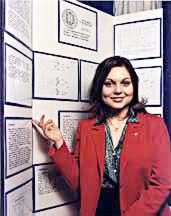|
Spring 1998 (6.1) How Kids Learn
Language
Photo: Ann Kromsky with posters describing her language project. With the help of University of California at Riverside (UCR) professor Curt Burgess, Kromsky created a computer model, called "HAL Jr," to study children's acquisition of language. HAL Jr. is based on the prototype of HAL (Hyperspace Analogue Language) which models adult language. Kromsky and Chomsky Kromsky's computer model was "fed" 1.7 million words that had been spoken by preschool-aged children, ages 2-6. Kromsky found this collection of words on the Internet from the Childes Data Base, a research study conducted at Carnegie-Mellon University in Pittsburgh. The words had been collected from children of different ages, races and backgrounds. Using a mathematical formula, she programmed the computer to group words with similar meanings and uses. According to Kromsky, the computer seems to "learn" the meaning of a word often after only two or three exposures in its natural context. She was also surprised to find how quickly ungrammatical structures, such as words like "wanna" and "gotta," were categorized and assigned meaning so quickly. From this information, HAL Jr. constructed a two-dimensional map for its 6,000-word vocabulary. Words that had similar meanings were clustered together more closely on the map. For example, words for food were in a different corner than words for toys. "Muffin," "cookie" and "bread" were very close together on the map, even though the definitions for these words had not been fed to the computer. HAL Jr. could even distinguish between nouns, verbs and adjectives. According to Kromsky, this shows that children learn language from hearing it, and that there is a mathematical basis for language. Discovering how humans learn languages can help us understand how the mind "maps" or categorizes new languages and should result, among other things, in saving us lots of time in learning new languages. Westinghouse Prize Kromsky's project was up against
stiff competition in the Westinghouse Search, now in its 57th
year. About 1,500 U.S. high school students qualify for the competition
each year. Each year the top 40 entries are named as finalists
and are invited to Washington D.C. to present their research,
meet leading scientists and undergo a further round of interviews
so that the top ten projects can be chosen. Even being picked as one of the 40 finalists was "mind-boggling" for Ann. She received the news early one morning in February. "They called from the East coast. Since I had just awakened, I wondered who was calling me so early in the morning. I couldn't believe it. I kept saying, 'Are you kidding me?' You have to understand that this is like the Nobel Prize for high school students." It wasn't the first time Kromsky had won a science competition. In 1996, she took first place at the California Science and Technology Museum contest and won $4,000 in scholarships. Outside the university computer laboratory, where her classmates always think she's older than she actually is, Kromsky enjoys singing with a Madrigal group at high school. Her initial interest in music began in Azerbaijan. So what does a Westinghouse award-winner do next? Many of the finalists from previous years have gone on to become professors and research scientists, some have even gone on to win prestigious honors such as the Nobel Prize, MacArthur Foundation Fellowships (the so-called "genius awards"), Sloan Research Fellows, Fields Medal for mathematics or membership into the National Academy of Sciences or National Academy of Engineering. Already, several graduate students
and Ph.D. candidates are expanding on ideas that Kromsky pioneered.
After finishing high school, she plans to enroll in a university.
She's not sure which one yet-there's been lots of offers. Possibly,
she'll continue in medicine or neurology. Wherever she goes,
however, the likelihood is great that her contribution in the
field of language acquisition will continue-and that HAL Jr.
is just a forerunner of things to come. |

